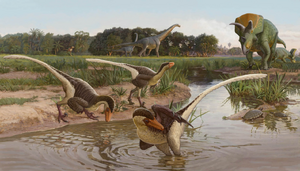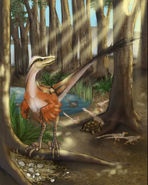(Adding categories) |
No edit summary |
||
| Line 1: | Line 1: | ||
[[File:Dineobellator_notohesperus.png|thumb|300px]] |
[[File:Dineobellator_notohesperus.png|thumb|300px]] |
||
| − | '''''Dineobellator''''' (" |
+ | '''''Dineobellator notohesperus''''' (meaning "Diné warrior") is a genus of dromeosaurid dinosaur that from the Late Cretaceous [[Ojo Alamo Formation]] of New Mexico. Its name comes from Diné, the Navajo word for their own people, and the Latin word "bellator," meaning "warrior." The holotype remains were first recovered in 2008, with additional material being discovered in 2009, with the remains being described as a new genus in 2020. ''Dineobellator'' was around 2 meters (6.6 feet) in length and is believed to have weighed about 18 to 22 kilograms (40 to 49 lbs). Unique features of the skeleton suggest greater hand and feet flexion than normal for dromaeosaurs, a tighter grip strength in the manual unguals, and greater movement at the tail base. These may have aided in agility and predation. ''Dineobellator'' is a member of the family [[Velociraptorinae]], with its presence, along with that of ''[[Acheroraptor]]'' and ''[[Dakotaraptor]]'', suggesting that dromaeosaurs were still diversifying by the end of the Cretaceous. |
| + | |||
| + | ==Discovery and naming== |
||
| + | |||
| + | ==Description== |
||
| + | |||
| + | ==Classification== |
||
| + | |||
| + | ==Paleobiology== |
||
| + | |||
| + | ==Paleoenvironment== |
||
==Gallery== |
==Gallery== |
||
Revision as of 03:48, 4 September 2020

Dineobellator notohesperus (meaning "Diné warrior") is a genus of dromeosaurid dinosaur that from the Late Cretaceous Ojo Alamo Formation of New Mexico. Its name comes from Diné, the Navajo word for their own people, and the Latin word "bellator," meaning "warrior." The holotype remains were first recovered in 2008, with additional material being discovered in 2009, with the remains being described as a new genus in 2020. Dineobellator was around 2 meters (6.6 feet) in length and is believed to have weighed about 18 to 22 kilograms (40 to 49 lbs). Unique features of the skeleton suggest greater hand and feet flexion than normal for dromaeosaurs, a tighter grip strength in the manual unguals, and greater movement at the tail base. These may have aided in agility and predation. Dineobellator is a member of the family Velociraptorinae, with its presence, along with that of Acheroraptor and Dakotaraptor, suggesting that dromaeosaurs were still diversifying by the end of the Cretaceous.

